英语词汇学习策略[1]
初中英语词汇学习策略
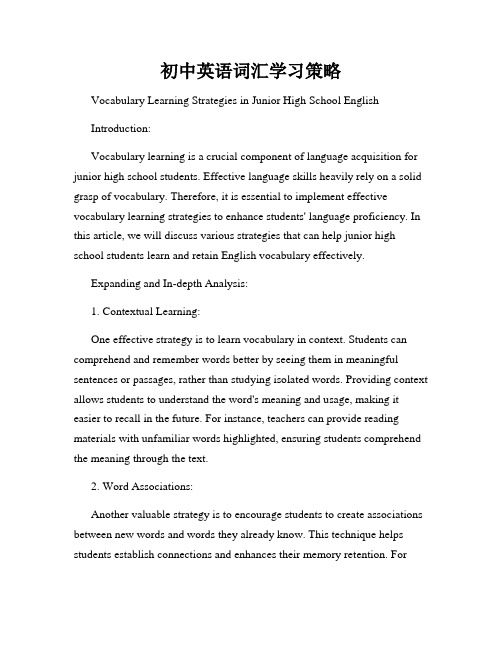
初中英语词汇学习策略Vocabulary Learning Strategies in Junior High School EnglishIntroduction:Vocabulary learning is a crucial component of language acquisition for junior high school students. Effective language skills heavily rely on a solid grasp of vocabulary. Therefore, it is essential to implement effective vocabulary learning strategies to enhance students' language proficiency. In this article, we will discuss various strategies that can help junior high school students learn and retain English vocabulary effectively.Expanding and In-depth Analysis:1. Contextual Learning:One effective strategy is to learn vocabulary in context. Students can comprehend and remember words better by seeing them in meaningful sentences or passages, rather than studying isolated words. Providing context allows students to understand the word's meaning and usage, making it easier to recall in the future. For instance, teachers can provide reading materials with unfamiliar words highlighted, ensuring students comprehend the meaning through the text.2. Word Associations:Another valuable strategy is to encourage students to create associations between new words and words they already know. This technique helps students establish connections and enhances their memory retention. Forexample, if the students encounter the word "enormous," they can associate it with "huge" or "gigantic," which they are already familiar with.3. Visual Aids:Visual aids play a significant role in vocabulary acquisition. Incorporating pictures, diagrams, or flashcards can help students visualize new words and associate them with their meanings. Teachers can use visual aids to introduce new vocabulary or create meaningful word maps to facilitate understanding and memory retention. Additionally, online resources and language learning applications provide interactive visual tools for effective vocabulary learning.4. Active Usage:Creating opportunities for students to actively use newly learned vocabulary is crucial for retention. Encouraging students to integrate new words into their speaking and writing activities promotes practical application and memorization. Teachers can allot time for discussions, debates, or group activities where students utilize target vocabulary. Reinforcing active usage enhances understanding and ensures long-term retention.5. Mnemonic Devices:Mnemonic devices are memory-enhancing techniques that assist students in remembering vocabulary through creative associations or patterns. Techniques such as acronyms, visualization, or rhymes can aid in retaining new words. For example, to remember the spelling of the word "necessary,"students can use the mnemonic "Never Eat Crispy Crust Apple, Remember You!" This technique adds a memorable aspect to the learning process.6. Review and Practice:Consistent review and practice are fundamental to reinforcing vocabulary learning. Students should regularly revise previously learned words and incorporate them into various activities. Engaging in vocabulary exercises, quizzes, or games helps students consolidate their knowledge and identify any areas of weakness. Repetition over time solidifies vocabulary retention and enhances students' language skills.In conclusion, implementing effective vocabulary learning strategies is of utmost importance for junior high school students. By incorporating contextual learning, word associations, visual aids, active usage, mnemonic devices, and regular review practices, students can enhance vocabulary acquisition and achieve better language proficiency. Employing a combination of these strategies in the classroom ensures a dynamic and engaging learning environment, facilitating students' overall language development.。
初中生英语词汇认知策略的训练
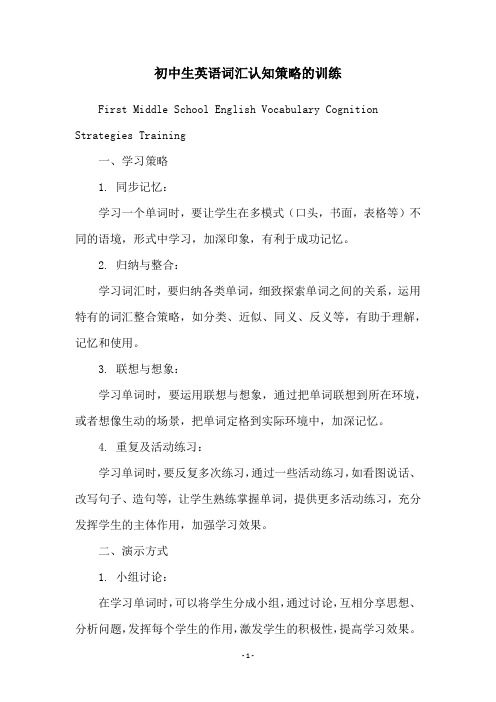
初中生英语词汇认知策略的训练
First Middle School English Vocabulary Cognition Strategies Training
一、学习策略
1. 同步记忆:
学习一个单词时,要让学生在多模式(口头,书面,表格等)不同的语境,形式中学习,加深印象,有利于成功记忆。
2. 归纳与整合:
学习词汇时,要归纳各类单词,细致探索单词之间的关系,运用特有的词汇整合策略,如分类、近似、同义、反义等,有助于理解,记忆和使用。
3. 联想与想象:
学习单词时,要运用联想与想象,通过把单词联想到所在环境,或者想像生动的场景,把单词定格到实际环境中,加深记忆。
4. 重复及活动练习:
学习单词时,要反复多次练习,通过一些活动练习,如看图说话、改写句子、造句等,让学生熟练掌握单词,提供更多活动练习,充分发挥学生的主体作用,加强学习效果。
二、演示方式
1. 小组讨论:
在学习单词时,可以将学生分成小组,通过讨论,互相分享思想、分析问题,发挥每个学生的作用,激发学生的积极性,提高学习效果。
2. 教师示范:
对于学生理解学习难点,或者关键词汇不懂的地方,教师可以示范性讲解,让学生理解掌握,有利于提高学习质量。
3. 问答练习:
让学生把学过的单词灵活运用,把学过的单词问答形式练习,询问单词意义与用法,有助于熟练掌握,并加深记忆。
4. 综合练习:
在学习单词时,应提供综合练习,使学生从不同角度和形式实践掌握词汇知识,形成词汇思维习惯,从而提高学习质量。
英语词汇学习方法策略

英语词汇学习方法策略词汇学习方法策略一、转变观念说起词汇的记忆,笔者有一个有趣的发现,在多数人不说“记单词”,而更习惯于说“背单词”。
其实,这并不仅仅是个用字的习惯问题,更反映人们对获得词汇途径的一种误解。
我们知道,记忆分为机械记忆和理解记忆两种。
这个“背”字恰好说明人们自觉不自觉地认为扩大词汇量的最有效途径主是机械记忆。
英语的单词、短语和习惯用法虽然可以靠机械记忆强记,从而达到短期的记忆效果,但更重要的是靠理解来达到彻底掌握的目的。
因为从效果来看,理解记忆的效果远远超过机械记忆,只有理解的东西才更容易记住,而且不容易遗忘。
二、记忆单词要有选择性英语词汇量惊人的丰富,总数达50.6o万个。
据统计,一个以英语为母语且受过高等教育的成年人也最多只能掌握其1/3左右。
对英语学习者来说,需掌握45Oo一5OOO个词汇来应付日常的听、说、读、写需要。
考虑到外语学习者的词汇量相当有限这一事实,我们必须有重点地选择记忆词汇,不能“抓到篮里都是菜”,碰到单词就重点记忆。
“根据词汇所表达的内容和使用范围,人们把词汇分为共同核心词汇与专用词汇。
共同核心词汇是全民通用的词汇,是词汇的核心部分,而专用词汇则是在某一行业、集团或者某一领域通用的词汇。
”无论是专业学习外语还是以外语为工具进行本专业的学习与研究,都必须从共核词汇人手,并以共核词汇为重点进行记忆。
选择了需记忆的词汇之后,还要按照学习的方式进行选择。
词汇的掌握可以分为领会式和复用式两种,“领会式掌握是指看到单词能理解其词义,复用式掌握是指能正确拼写单词,英汉互译,并掌握其基本用法。
”领会式词汇亦可称为理解词汇(Vo~.1aryforRecognition),复用式词汇亦可称为活用词汇(Vo~yforProduction)。
认识到这一点,我们就可以通过精读与泛读的方式来系统地扩大词汇量。
精读通过对课文的详细分析来掌握复用式词汇,同时也可以学习一些领会式词汇;泛读帮助我们扩充领会式词汇,增强语感,提高阅读能力,同时也可以巩固已学过的复用式词汇。
英语中常见的学习策略有哪些?
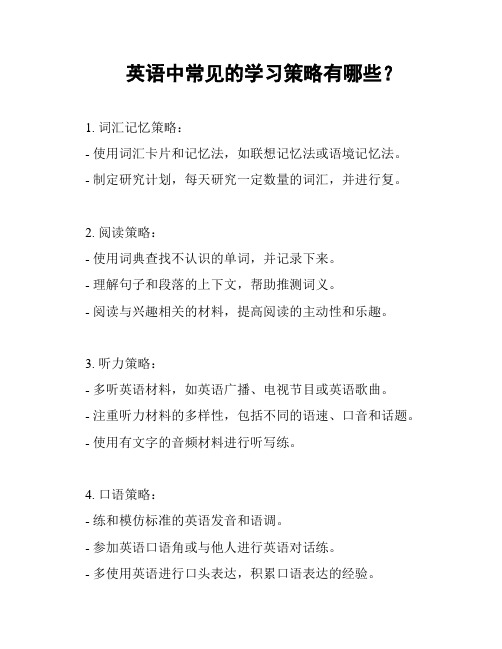
英语中常见的学习策略有哪些?
1. 词汇记忆策略:
- 使用词汇卡片和记忆法,如联想记忆法或语境记忆法。
- 制定研究计划,每天研究一定数量的词汇,并进行复。
2. 阅读策略:
- 使用词典查找不认识的单词,并记录下来。
- 理解句子和段落的上下文,帮助推测词义。
- 阅读与兴趣相关的材料,提高阅读的主动性和乐趣。
3. 听力策略:
- 多听英语材料,如英语广播、电视节目或英语歌曲。
- 注重听力材料的多样性,包括不同的语速、口音和话题。
- 使用有文字的音频材料进行听写练。
4. 口语策略:
- 练和模仿标准的英语发音和语调。
- 参加英语口语角或与他人进行英语对话练。
- 多使用英语进行口头表达,积累口语表达的经验。
5. 写作策略:
- 阅读优秀的英语写作范例,研究写作技巧和表达方式。
- 多写作练,如写日记、写作文等,提高写作的流畅性和准确性。
- 请他人修改和纠正自己的写作,及时改进错误和不足之处。
6. 文化研究策略:
- 研究并了解英语国家的文化背景、俗和传统。
- 阅读英语国家的文化杂志、报纸等,扩展对文化的了解。
- 参加英语国家的文化活动或与母语为英语的人交流,增进跨文化交流能力。
这些学习策略能够帮助提高英语学习效率和成果。
建议根据自己的学习需求和兴趣,选择合适的策略进行实践和调整,持之以恒地进行学习。
英语词汇学习方法策略
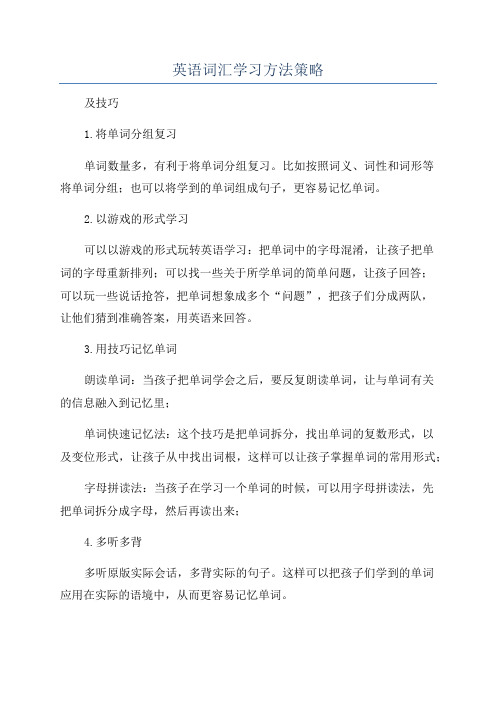
英语词汇学习方法策略
及技巧
1.将单词分组复习
单词数量多,有利于将单词分组复习。
比如按照词义、词性和词形等
将单词分组;也可以将学到的单词组成句子,更容易记忆单词。
2.以游戏的形式学习
可以以游戏的形式玩转英语学习:把单词中的字母混淆,让孩子把单
词的字母重新排列;可以找一些关于所学单词的简单问题,让孩子回答;
可以玩一些说话抢答,把单词想象成多个“问题”,把孩子们分成两队,
让他们猜到准确答案,用英语来回答。
3.用技巧记忆单词
朗读单词:当孩子把单词学会之后,要反复朗读单词,让与单词有关
的信息融入到记忆里;
单词快速记忆法:这个技巧是把单词拆分,找出单词的复数形式,以
及变位形式,让孩子从中找出词根,这样可以让孩子掌握单词的常用形式;
字母拼读法:当孩子在学习一个单词的时候,可以用字母拼读法,先
把单词拆分成字母,然后再读出来;
4.多听多背
多听原版实际会话,多背实际的句子。
这样可以把孩子们学到的单词
应用在实际的语境中,从而更容易记忆单词。
英语词汇学习策略(1)

cold, especially in the north of the country.
The temperature may fall below 0゜, and
then there is often snow and ice. The best
season of the year is probably late spring.
英语词汇学习策略(1)
Zip was stopped during the war and only after the war did it become popular. What a difference it has made to our lives? It keeps people at home much more. It has made the remote parts of the world more real to us. Photographs show a country, but only zip makes us feel that a foreign country is real. Also we can see scenes in the street, big occasions are zipped, such as the coronation (加冕典礼) in 1953 and the Opening of Parliament. Perhaps the sufferers from zip are the notable people, who, as they step out of an airplane, have to face the battery of zip cameras and know that every movement, every gesture will be seen by millions of people. Politicians not only have to speak well, they now have to have what is called a “zip personality”. Perhaps we can sympathize when Members of Parl英ia语m词汇e学习n策t略s(1a) y that they do not want debates to be zipped.
新课标下高中英语词汇学习策略
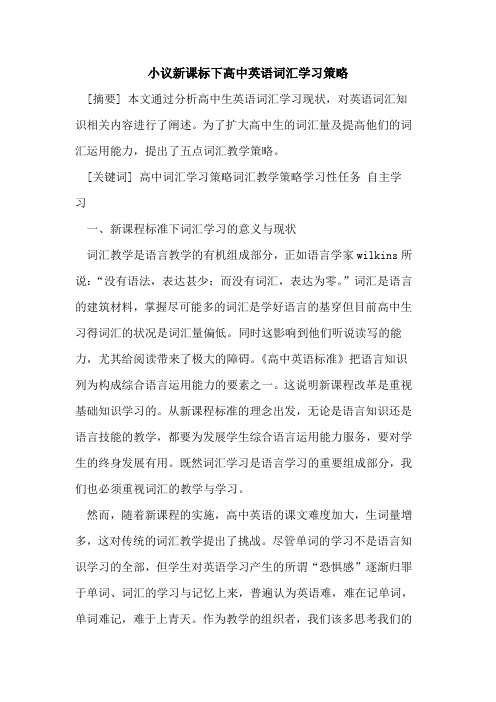
小议新课标下高中英语词汇学习策略[摘要] 本文通过分析高中生英语词汇学习现状,对英语词汇知识相关内容进行了阐述。
为了扩大高中生的词汇量及提高他们的词汇运用能力,提出了五点词汇教学策略。
[关键词] 高中词汇学习策略词汇教学策略学习性任务自主学习一、新课程标准下词汇学习的意义与现状词汇教学是语言教学的有机组成部分,正如语言学家wilkins所说:“没有语法,表达甚少;而没有词汇,表达为零。
”词汇是语言的建筑材料,掌握尽可能多的词汇是学好语言的基穿但目前高中生习得词汇的状况是词汇量偏低。
同时这影响到他们听说读写的能力,尤其给阅读带来了极大的障碍。
《高中英语标准》把语言知识列为构成综合语言运用能力的要素之一。
这说明新课程改革是重视基础知识学习的。
从新课程标准的理念出发,无论是语言知识还是语言技能的教学,都要为发展学生综合语言运用能力服务,要对学生的终身发展有用。
既然词汇学习是语言学习的重要组成部分,我们也必须重视词汇的教学与学习。
然而,随着新课程的实施,高中英语的课文难度加大,生词量增多,这对传统的词汇教学提出了挑战。
尽管单词的学习不是语言知识学习的全部,但学生对英语学习产生的所谓“恐惧感”逐渐归罪于单词、词汇的学习与记忆上来,普遍认为英语难,难在记单词,单词难记,难于上青天。
作为教学的组织者,我们该多思考我们的学生究竟应该学什么词汇、学到什么程度、用什么方法学。
在新课改实施过程中,笔者深深体会到新课程改革给高中英语词汇教学带来的一系列困惑。
二、培养学生词汇学习策略的重要性笔者在平时实施词汇教学的过程中,通过定期有意识地对学生自身的词汇学习状况进行了调查发现,学生在英语词汇学习方面欠缺适当、适时的词汇学习策略指导。
要增强学生学习词汇的积极性,促进自主学习,提高词汇学习效果,这就需要教师通过“如何学词汇”的训练,帮助学生形成有效的词汇学习策略,并能适时地调整自己的词汇学习策略。
三、新课程标准下高中词汇教学策略1、记忆策略。
英语词汇教学策略

英语词汇教学策略
英语词汇教学策略主要包括以下几个方面:
1.重视语音教学:语音是词汇学习的基础,通过教授音标和单词发音规则,帮助学生掌握单词的发音和拼写规律,提高记忆效率。
2.结合语境教学:将词汇放在具体的语境中教学,有助于学生理解词汇的含义和用法,增强记忆效果。
3.注重词汇的搭配和用法:词汇的搭配和用法是词汇教学的重点,通过教授固定短语、习惯用法等,帮助学生掌握常用词汇的搭配和用法,提高语言运用能力。
4.引导学生自主学习:鼓励学生通过阅读、听力等途径积累词汇,培养自主学习能力。
5.及时复习巩固:词汇学习需要反复巩固,通过及时复习和检测,帮助学生加深记忆,巩固所学词汇。
6.运用多种教学方法:采用多种教学方法,如直观教学、游戏教学、情境教学等,增强词汇教学的趣味性和实效性。
7.培养跨文化意识:了解英语国家的文化背景和语言习惯,有助于学生更好地理解和运用英语词汇,提高跨文化交流能力。
总之,英语词汇教学需要注重语音、语境、搭配和用法的教学,引导学生自主学习,并及时复习巩固,运用多种教学方法,培养跨文化意识。
- 1、下载文档前请自行甄别文档内容的完整性,平台不提供额外的编辑、内容补充、找答案等附加服务。
- 2、"仅部分预览"的文档,不可在线预览部分如存在完整性等问题,可反馈申请退款(可完整预览的文档不适用该条件!)。
- 3、如文档侵犯您的权益,请联系客服反馈,我们会尽快为您处理(人工客服工作时间:9:00-18:30)。
PPT文档演模板
英语词汇学习策略[1]
1)根据同义关系猜测词义
例如:
(1) In order to discover who had a natural ability to learn languages, the students were given tests to determine their language aptitude.
PPT文档演模板 Adrian Doff
英语词汇学习策略[1]
In Britain, the weather is very varied;people
never know what it will be like the next day.
The summer is warmer than the winter, but
PPT文档演模板
英语词汇学习策略[1]
3、应该学习哪些词汇? 一般的学习者和初学英语的学习者,中学生 应该将精力和时间投入到那些频率更高的词 汇的学习上。 那么什么是使用频率高的词?什么是使用频 率低的词呢?
PPT文档演模板
英语词汇学习策略[1]
总的来说,我们可以把英语词汇分为两类:
1)积极词汇:active vocabulary又泽:主动性词 汇
even in summer the average temperature is
only 16゜. Sometimes the sun shines, but at
other times the sky is covered in cloud, and
it often rains. In winter it is sometimes very
At this time of year the Weather is often
.
PPT文档演模板
英语词汇学习策略[1]
sunny and quite warm; the countryside looks very green, and there are wild flowers everywhere.
jobs. Rote means ______.
a. creative
b. mechanical
c. fondness
(2) It is better to be reflective about problems than to be
thoughtless. Reflective means _______.
英语词汇学习策略[1]
2、为什么要学习词汇?
其实,每个英语学习者都有不同的学习目的, 同一个学习者在不同的学习阶段也有不同 的学习目标。词汇学习也是这样。学习词 汇时,每个学习者都应该问自己一个问题: 在目前阶段我为什么要学习英语词汇?对 这个问题的回答会直接影响学习者对词汇 的选择和词汇学习策略的运用。
a. free-thinking b. traditional
c. old
PPT文档演模板
英语词汇学习策略[1]
3)根据整个句子的意思猜测词义 例如:
(1)She loves music: she can play the guitar, the piano and the cello.
(2) He walked into the sitting-room and sat down on the settee.
“Words which students will need to understand and also use themselves. We call this active vocabulary. In teaching active vocabulary, it is usually worth spending time giving examples and asking questions, so that students can really see how the word is used.”
next week? B: Well, let me check my diary.
例2: He is a five-foot-tall man. The building is 40 feet high.
PPT文档演模板
英语词汇学习策略[1]
二、英语词汇学习策略
1、利用语境 我们认为教师仅仅提倡还是不够的,教师需 要引导、培养、训练学生具有从上下文中猜 测单词词义的能力。关于从上下文猜测词义 我们建议有以下几种做法:
Zip was stopped during the war and only after the war did it become popular. What a difference it has made to our lives? It keeps people at home much more. It has made the remote parts of the world more real to us. Photographs show a country, but only zip makes us feel that a foreign country is real. Also we can see scenes in the street, big occasions are zipped, such as the coronation (加冕典礼) in 1953 and the Opening of Parliament. Perhaps the sufferers from zip are the notable people, who, as they step out of an airplane, have to face the battery of zip cameras and know that every movement, every gesture will be seen by millions of people. Politicians not only have to speak well, they now have to have what is called a “zip personality”. Perhaps we can sympathize when Members of Parliament say that PPT文档演模板 they do not want debates to be zip英p语e词汇d学.习策略[1]
PPT文档演模板
英语词汇学习策略[1]
这种鼓励脱离语境地记单词的结果是:学习 者只能记忆单词的一两种意思,忽视了该单 词的其他意思,而且还不知道如何在不同的 语境中灵活地使用这些单词。
PPT文档演模板
英语词汇学习策略[1]
例1: A: Can we have a meeting sometime
PPT文档演模板
英语词汇学习策略[1]
Active Passive
Active weather cloud spring sunny (snow?) (ice?)
Passive varied temperature average season countryside (snow?)
PPT文档演模板
PPT文档演模板
英语词汇学习策略[1]
Which are active vocabulary or which are the passive vocabulary?
weather varied average cloud snow ice season
sunny countryside
temperature spring
英语词汇学习策略
PPT文档演模板
2020/12/17
英语词汇学习策略[1]
一、英语词汇学习
1、英语词汇学习的要求
级别
相对
知识
目标描述
年级
二级
小学 毕业
词汇
1.学习有关本级话题范围的600-700个单词和 50个左右的习惯用语;
2.了解单词是由字母构成的。
五级
初中 毕业
词汇
1.了解英语单词包括单词、短语、习惯用语和固 定搭配等形式;
(2) The job applicant sat in the personnel office and filled out a vita. When she finished the resume, she gave it to the secretary.
(3) Tom answered quickly. But after he
(3) Look! There’s a big fly on the window.
PPTHale Waihona Puke 档演模板英语词汇学习策略[1]
4) 根据段落或篇章的上下文来猜测词义
在理解段落或篇章的大环境时,根据文章中 的各种关系,读者可能会发现猜测词义的 另一些线索,从而推断出生词的大意。
PPT文档演模板
英语词汇学习策略[1]
thought about the matter more carefully,
he regretted having made such a hasty
decision.
PPT文档演模板
英语词汇学习策略[1]
2)根据反义关系猜测词义
例如:
(1)She has a love of rote work, but no fondness for creative
cold, especially in the north of the country.
The temperature may fall below 0゜, and
then there is often snow and ice. The best
